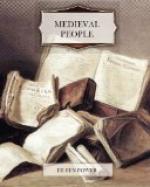Much dancing the house doubtless saw under the beautiful carved roof of the hall, with much song, games, kissing, and general abandon. Even when the bride and groom retired to the bridal chamber with its roll-moulded beams the merry-making was not done; they must hold a levee to their nearest friends in the bedchamber itself, enthroned in the great four-poster bed. There was no false delicacy about our ancestors. Indeed, as Henry Bullinger says (he was a very different person from jovial Deloney, but he was a contemporary of Paycocke’s, and Coverdale translated him, so let him speak): ’After supper must they begynne to pype and daunce agayne of the new. And though the yonge parsones, beynge weery of the bablyng noyse and inconuenience, come ones towarde theyer rest, yet can they haue no quietnesse. For a man shall fynd unmanerly and restlesse people, that will first go to theyr chambre dore, and there syng vycious and naughtie balates that the deuell maye haue his triumphe now to the vttermost.’[11] What would we not give for one of those ‘naughty ballads’ today?
The bride Margaret, who was somewhat after this merry fashion brought home to Coggeshall, came from Clare, the ancient home of the Coggeshall Paycockes. She was the daughter of one Thomas Horrold, for whose memory Paycocke retained a lively affection and respect, for in founding a chantry in Coggeshall Church he desired specially that it should be for the souls of himself and his wife, his mother and father, and his father-in-law, Thomas Horrold of Clare. He also left five pounds, with which his executors were ’to purvey an oder stone to be hade to Clare chirch and layd on my ffader in lawe Thomas Horrold w’t his pycture and his wife and childryn thereon’ (i.e. a memorial brass), and also five cows or else three pounds in money to Clare Church ’to kepe and mayntene my ffader in lawe Thomas Horrold his obitt’. He also left money to his wife’s brother and sisters. Margaret Paycocke died before her husband and without children; and the only young folk of his name whom Thomas ever saw at play in his




